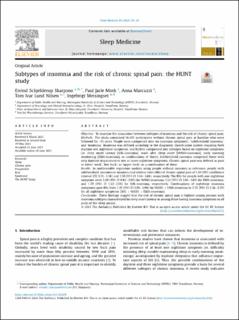| dc.description.abstract | Objective: To examine the association between subtypes of insomnia and the risk of chronic spinal pain. Methods:The study comprised 16,401 participants without chronic spinal pain at baseline who were followed for ~11 years. People were categorized into ‘no insomnia symptoms’,‘subthreshold insomnia’,and ‘insomnia’. Insomnia was defined according to the diagnostic classification system requiring both daytime and nighttime symptoms, and further categorized into subtypes based on nighttime symptoms(ie, sleep onset latency [SOL-insomnia], wake after sleep onset [WASO-insomnia], early morning awakening [EMA-insomnia], or combinations of these). Subthreshold insomnia comprised those with only daytime impairment or one or more nighttime symptoms. Chronic spinal pain was defined as pain in either ‘neck’, ‘low back’, or ‘upper back’, or a combination of these. Results: In multivariable regression analysis using people without insomnia as reference, people with subthreshold insomnia or insomnia had relative risks (RRs) of chronic spinal pain of 1.29 (95% confidence interval [CI] 1.21e1.38) and 1.50 (95% CI 1.34e1.68), respectively. The RRs for people with one nighttime symptom were 1.30 (95% CI 0.83e2.05) for WASO-insomnia, 1.32 (95% CI 1.06e1.65) for EMA-insomnia, and 1.70 (95% CI 1.32e2.18) for SOL-insomnia, respectively. Combinations of nighttime insomnia symptoms gave RRs from 1.45 (95% CI 1.08e1.94) for WASOþEMA-insomnia to 1.72 (95% CI 1.36e2.19)for all nighttime symptoms (SOLþWASOþEMA-insomnia). Conclusions: These findings suggest that the risk of chronic spinal pain is highest among persons with insomnia subtypes characterized by sleep onset latency or among those having insomnia symptoms in allparts of the sleep period. | en_US |

